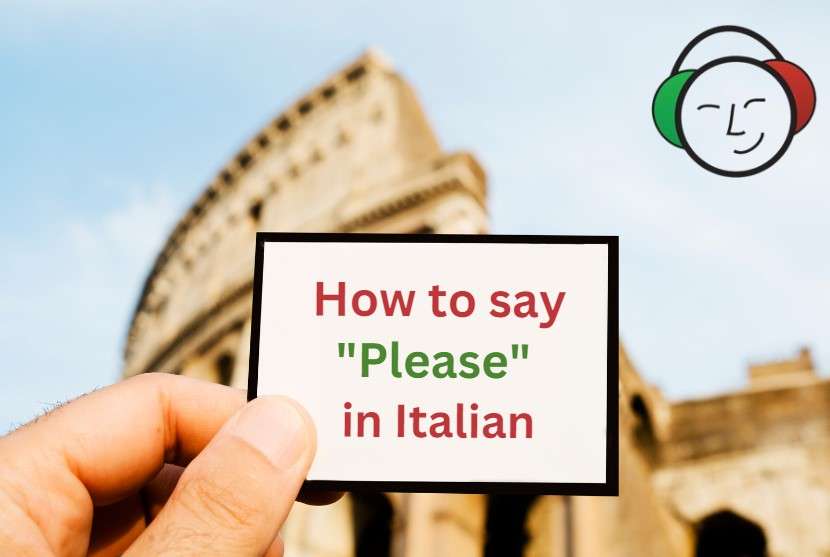How to Say Please in Italian: 10 Common Ways (w. Audio)
Mastering the art of saying please in Italian is vital when navigating Italy. Italians value formality when interacting with older adults or strangers, so good manners, or “buone maniere,” are crucial for avoiding embarrassing faux pas.
Mastering Politeness: The Art of Saying Please in Italian
You might find it unexpected that there isn’t a single Italian word directly translated to “please” in Italian. As a beginner, you may know the most common translation, “per favore.”
However, there are several ways to say please in Italian, and the phrase you choose depends on the tone of the conversation, the nature of the relationship between speakers, context, urgency, and even regional differences.
In Italian, expressing “please” is more intricate than simply adding a “per favore” at the end of your request. With the help of native speakers, this guide will introduce you to ten key phrases and common ways to say please in Italian, tailored to various situations you may come across.
10 Common Ways to Say Please in Italian

1. Per favore
“Per favore” (pronounced pehr fah-voh-reh) is one of the first Italian phrases you’ll learn when studying this enchanting language, and it is the most common way to say please in Italian.
You can use it in various situations, including with friends, family, and colleagues. This versatile phrase is probably the best way to say please because it’s suitable for almost all scenarios: addressing one person or a group in casual or formal settings.
Potresti passarmi il sale, per favore?
Could you pass me the salt, please?
Per favore, potete darmi informazioni sugli orari del treno?
Please, can you give me information about the train schedule?
Mi porta il conto, per favore?
Can you bring me the check, please?
How do you say “Please may I have” in Italian?
In Italian, “Please may I have” is either “Posso avere, per favore” or “Potrei avere, per favore”.
How do you say “Please can I have” in Italian?
In Italian, “Please can I have” is translated as “Posso avere, per favore” or “Potrei avere, per favore.” You might have noticed that “Please may I have” and “Please can I have” translate the same in Italian.
2. Per piacere
“Per piacere” shares the same meaning and usage as per favore; the two phrases are interchangeable. “Per piacere” is a flexible way to say please in Italian while asking for something in a polite way.
It suits formal and informal settings and can be directed toward groups or individuals.
Potrei avere un bicchiere d’acqua, per piacere?
May I have a glass of water, please?
Per piacere, potresti dirmi l’indirizzo del ristorante?
Please, could you tell me the address of the restaurant?
3. Per cortesia
“Per cortesia” is another valuable way to say please in Italian. In Italian, “cortesia” translates to courtesy or favor.
While “per cortesia” is nearly interchangeable with “per favore” and “per piacere,” it leans slightly towards a more formal tone. You’re less likely to hear “per cortesia” among close friends or family members; it’s more common in formal settings or when making polite requests.
Use “per cortesia” when you want to be extra respectful, for instance, when speaking to older people, strangers, people of a higher status or position, service industry professionals like waitstaff and shopkeepers, or even your boss.
Per cortesia, potrebbe dirmi l’ora?
Could you please tell me the time?
Note: “Per cortesia” is the preferred method to ask for the time of day.
Mi scusi, mi potrebbe passare il menu, per cortesia?
Excuse me, could you pass me the menu, please?
In this last example, native Italian speakers use “per cortesia” to add extra emphasis on politeness. This phrase is especially suitable when you want to make a respectful request, demonstrating a considerate and courteous approach to communication.
4. Ti prego / La prego / Vi prego
Sometimes you must say please, and a simple, polite request won’t suffice. Perhaps the situation is urgent, you’re exasperated, or you’ve made the same request before without success.
It might even be an emergency. In these instances, “ti prego,” “la prego,” or “vi prego” are more fitting. These phrases directly translate to I beg you or I implore you, giving them a more dramatic flair. They utilize the verb “pregare,” which means beg, implore, and pray.
Ti prego, ascoltami!
Please, listen to me!
La prego, mi dia informazioni sul prossimo treno.
Please, provide me with information about the next train.
Suggested Read: How to Travel by Train in Italy: A Guide to Easy Rides
5. La preghiamo
“La preghiamo di (+ infinitive verb)” is a phrase used for formal requests. The direct translation is “we beg you to,” and it’s similar to saying “we kindly ask you to (+ verb).” You’ll hear it in formal or official situations.
La preghiamo di rispettare le regole del parco.
We kindly ask you to respect the park rules.
La preghiamo di spegnere il cellulare durante la cerimonia.
We kindly ask you to turn off your cell phone during the ceremony.
La Prego vs. La Preghiamo: What’s the Difference?
“La prego” is used when one individual is addressing another, while “La preghiamo” is used when a group (such as an entity, company, organization, or collective of people) is addressing an individual.
6. Si prega di / Siete pregati di
These are additional ways to say please in Italian. These phrases are often found on signs, invitations, and official announcements where individuals are invited or requested to do something.
“Si prega di (+ infinitive verb)” is the impersonal form of the verb pregare, which translates to beg, implore, and pray in Italian. This form is employed in impersonal and formal situations to ask people to take action.
“Siete pregati di (+ infinitive verb)” is the passive plural form of pregare, meaning “you are implored to + verb.” This phrase is used similarly to “si prega di,” as it addresses groups of people.
Si prega di non fumare in questo locale.
Please do not smoke in this establishment.
Siete pregati di non parcheggiare qui.
You are kindly asked not to park here.
7. Cortesemente
“Cortesemente” can be translated as “courteously” or “kindly,” but in some contexts, rendering it as “please” is also appropriate. “Cortesemente” is used in written communication or relatively formal spoken situations.
It can be combined with phrases like “si prega” and “la prego” for added emphasis. Cortesemente is primarily employed in written communication rather than spoken conversations.
Cortesemente, potrebbe controllare il mio documento?
Could you please check my document?
La prego cortesemente di rispondere al più presto.
Please kindly reply as soon as possible.
8. Gentilmente
“Gentilmente” is a close synonym of cortesemente but is less formal and friendlier. It might be used in family settings or with acquaintances when extra kindness is desired. It is rarely seen in written form.
Translated literally, it means “kindly,” “courteously,” or “politely.” It is often used in affirmative sentences to express a desire for something to be fulfilled.
Potresti gentilmente passarmi il sale?
Could you kindly pass me the salt?
Gentilmente, potrebbe mostrarmi la direzione giusta?
Could you please show me the right direction?
9. Sì, grazie (accepting an offer)
Although it might initially feel unusual to accept an offer and say yes please in Italian, use “yes, thank you” (“sì, grazie”). This applies in all settings, from formal to informal, whether you’re speaking to one person or a group.
Vuoi un caffè? Sì, grazie.
Would you like a coffee? Yes, please.
Desidera un bicchiere d’acqua? Sì, grazie.
Would you like a glass of water? Yes, please.
10. Using “prego” to say please in Italian
You might already know the word prego as a way to say “you’re welcome” in Italian, in response to “grazie” (thank you). “Prego” can also say please in Italian when inviting someone to do something.
Prego, accomodatevi.
Please, have a seat.
Prego, prendete un biscotto.
Please, help yourself to a cookie.
Using “Il conto, prego” to ask for the check in Italian restaurants
When asking for the check at a restaurant in Italy, you could use the term “Il conto, prego”, with “prego” serving as “please”. This phrase translates to “the check, please” in English.
Mastering the Italian translation of please is invaluable for anyone learning the language or traveling to Italy, where interacting with Italian people is essential.
Familiarizing yourself with the various useful phrases for expressing this polite request can significantly enhance your communication skills and enable you to navigate different social situations more effectively.
While some phrases are more formal than others, it is essential to adapt your choice of words depending on the context, tone of the conversation, and the relationship between speakers.
Adapting to Context: Choosing the Right Way to Say Please in Italian

From the basic and versatile “per favore” and “per piacere” to the more formal “per cortesia” and “cortesemente,” there are plenty of options for conveying politeness in Italian.
“Ti prego,” “la prego,” and “vi prego” add a sense of urgency to your request, while “la preghiamo” is perfect for official situations.
“Si prega di” and “siete pregati di” are commonly found in signs and announcements, while “gentilmente” offers a friendlier touch to your request.
To accept an offer, say “sì, grazie,” and remember that “prego” can also be an invitation.
Enhancing Your Italian Experience through Politeness and Good Manners
By mastering these expressions, you will avoid faux pas in Italian society and demonstrate respect and good manners, which are highly valued in Italian culture.
Just as importantly, you will be able to engage in more meaningful interactions with Italian speakers, making your overall experience in the country all the more enjoyable and enriching.
So, as you embark on your Italian language journey or plan your trip to Italy, take the time to practice these phrases and incorporate them into your daily conversations.
Soon enough, saying “please” in Italian will become second nature, and you’ll be well-equipped to easily and confidently navigate Italian culture’s diverse and captivating world.
Suggested Read:







